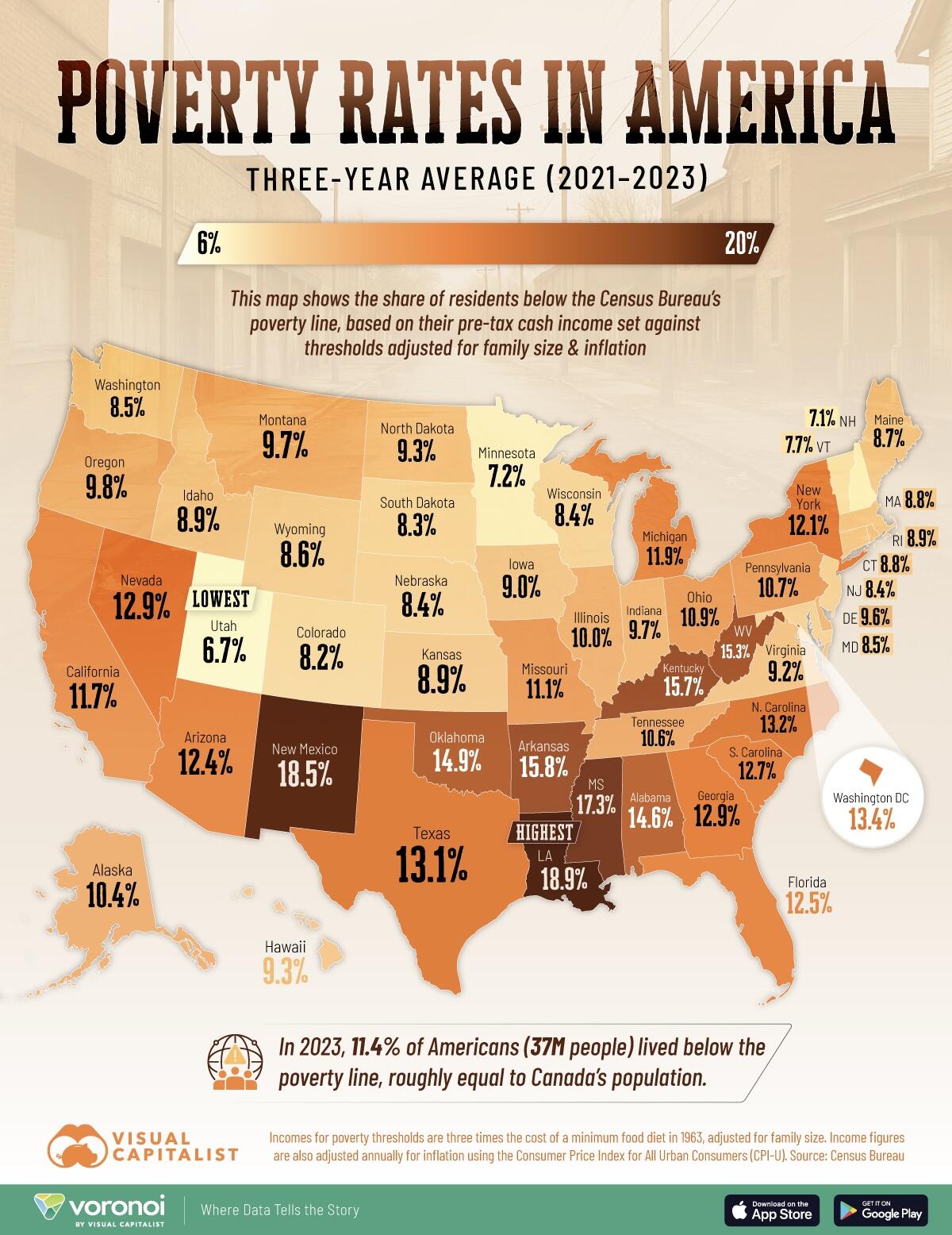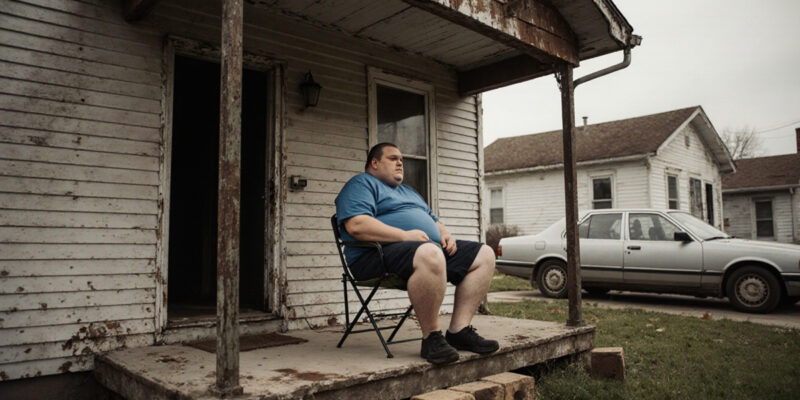You might have seen this graphic which is making the rounds on the internet today. We saw it in a post at Zerohedge, but it’s getting shared a bit…

Zerohedge’s writeup isn’t particularly friendly to the Bayou State…
Louisiana tops the list at 18.9%, leaving nearly one in five residents below the poverty threshold despite the state’s large energy sector.
In other words, no excuses for us.
Here’s how these numbers are arrived at…
The U.S. Census Bureau calculates poverty lines using pretax household income against a threshold at three times the cost of a minimum food diet from 1963, adjusted for family size and inflation.
For reference, this is a quick guide on how much a household needs to be earning to be considered below the poverty line in 2023.
- One person: ≤$15,480
- Two people: ≤$19,680
- Three people: ≤$24,230
- Four people: ≤$31,200
There’s another item out there which, in tandem with this one, doesn’t make for a great picture…
https://twitter.com/stats_feed/status/1959936292332163296?ref_src=twsrc%5Etfw%7Ctwcamp%5Etweetembed%7Ctwterm%5E1959936292332163296%7Ctwgr%5E90552a948de46c262cb152de50f554754167bf20%7Ctwcon%5Es1_&ref_url=https%3A%2F%2Fwww.tigerdroppings.com%2Frant%2Fpolitics%2Fdoes-fatness-obesity-indicate-the-potential-political-leaning-of-a-states-populace%2F119834703%2F
So 40 percent of our people are obese and 19 percent are in poverty.
What percent of Louisiana’s poor people are obese?
You’d think the number would be few, right? If you’re poor you don’t get enough to eat and so you can’t be obese.
But that’s not how it works. Doing a Grok search for stats on whether Louisiana’s poor are obese finds some ugly results…
Yes, statistics on obesity rates among low-income Louisianans (as a proxy for those living in poverty) are available from sources like the Behavioral Risk Factor Surveillance System (BRFSS), which tracks self-reported health data. Household income is commonly used as an indicator of poverty status, given that the federal poverty level in recent years has ranged from approximately $14,000–$15,000 for a single-person household up to around $30,000 for a family of four. Thus, the lowest income brackets (e.g., <$15,000 or <$25,000 annually) often align closely with poverty thresholds.Key Statistics from Recent Data
- 2023 Data (from aggregated BRFSS analysis): Among Louisiana adults with an annual household income less than $15,000, 45.5% are obese (defined as a body mass index, or BMI, of 30 or higher). This group represents a strong proxy for individuals living below the poverty line.
- 2021 Data (from Louisiana BRFSS Report): Among Louisiana adults with an annual household income less than $25,000, 44.3% are obese. For context, this income bracket includes many households at or below poverty levels, and the obesity rate here is notably higher than the state average of 38.6%.
These figures are based on self-reported height and weight data, which may slightly underestimate true prevalence due to reporting biases. Overall, Louisiana’s adult obesity rate has risen to about 40% as of 2023, and studies consistently show a strong association between lower income/poverty and higher obesity rates, driven by factors like limited access to healthy foods, safe physical activity spaces, and healthcare.
So more than 45 percent of Louisiana’s poor are also obese. How does this factor into things like Medicaid? Get ready for some more ugly numbers…
- Survey-Based Estimates (Proxy via Income, 2021 BRFSS Data): Among Louisiana adults with an annual household income less than $25,000 (aligning closely with Medicaid eligibility thresholds, which are up to 138% of the federal poverty level, or roughly $20,120 for an individual and $41,400 for a family of four), 44.3% are obese (BMI ≥30). This is higher than the state adult average of 39.9%. For context, obesity rates decrease with higher income: 40.4% for $25,000–$49,999, 42.9% for $50,000–$74,999, and 38.9% for $75,000+.
- Claims-Based Estimates (Direct from Medicaid Data, 2022): Among Louisiana Medicaid Managed Care enrollees, the overall obesity prevalence is 10.86% (177,070 diagnosed out of 1,676,070 total enrollees), based on medical claims with an obesity diagnosis. This breaks down to 12.80% for adults (≥18 years) and 8.24% for children (<18 years). However, reports explicitly note this is an underestimate due to under-coding in claims; the true rate is likely much higher, aligning closer to survey data and the state’s overall adult rate of 40.1% in 2022.
These figures are self-reported (BRFSS) or claims-derived and may underestimate prevalence due to reporting biases or incomplete diagnoses. Factors like limited access to nutritious foods and physical activity in low-income areas contribute to higher rates among Medicaid populations. For children in public insurance programs (including Medicaid), older 2007 data shows 41.2% overweight or obese, compared to the state’s current overall child obesity rate of 23.1% (ages 6–17). More recent child-specific breakdowns by insurance are not readily available in public reports.
So what are we doing here?
A couple of things are obviously true. First, this state needs a much more robust economy. We need a whole lot more industry and a whole lot more people working. There’s some good news on that front, which is that a few months ago the state finally got back over two million people employed in non-farm jobs, which was a number we hit when Bobby Jindal was governor and then spent a decade below it.
Another Grok search indicates that the June JOLTS numbers (JOLTS stands for the U.S. Bureau of Labor Statistics’ Job Openings and Labor Turnover Survey) had Louisiana with 104,000 unfilled jobs, which is a reasonably high number and an indication we have a skills mismatch between what employers are looking for and what our workforce can supply. This is a periodic problem, of course, because our public schools have been awful pretty much forever.
But the thing is that when you have more than 850,000 poor people in your state and only 104,000 unfilled jobs, training people up isn’t altogether the answer. There isn’t enough economic activity to soak all these people up and lift them out of poverty.
But even that isn’t really the issue. How does Louisiana rate with respect to labor force participation?
Not very well, actually. Per Grok…
Louisiana’s seasonally adjusted civilian labor force participation rate was 58.0% as of July 2025, the most recent month available.
This is below the national average of approximately 62.2% for the same period. Among the 50 states, Louisiana ranks 43rd (where 1st is the highest rate and 50th is the lowest). For context, the highest rates were in Nebraska and North Dakota (both 69.4%), and the lowest was in West Virginia (54.3%).
So you have a very, very large percentage of people who are (1) fat, (2) poor and (3) not doing anything to better their lives.
It isn’t a question of the state’s economy not being robust enough to soak up our poor into the workforce and lift them into the middle class. The economic activity that is missing isn’t from our entrepreneurs – it’s from the poor.
And it isn’t so much that they’re poor. They’re unproductive. They’re literally sitting around getting fat on the spoils of the welfare system.
There will be people reading this and getting offended. Certainly it’ll be called “racist.” I’ll note that I’ve not made a single reference to race. This is about people with unhealthy and unproductive life habits who aren’t producing any wealth to move their families forward.
When the natural human inclination is toward betterment.
Ben Franklin had a famous quote. “I am for doing good to the poor,” he said, “but…I think the best way of doing good to the poor, is not making them easy in poverty, but leading or driving them out of it. I observed…that the more public provisions were made for the poor, the less they provided for themselves, and of course became poorer. And, on the contrary, the less was done for them, the more they did for themselves, and became richer.”
We do very, very little in the way of following Franklin’s advice.
Earlier today we picked up that Center Square piece by Nolan Mckendry about how the State Bond Commission just authorized $38 million in bonds to finance “affordable housing” in New Orleans at something like $600,000 per unit. This is utterly idiotic; taxpayer dollars shouldn’t be spent giving below-market housing to people already comfortable in their poverty.
This is incentivizing people to be poor.
Every summer we get left-wing activists screaming about SNAP benefits to kids who aren’t in school, when if your kid needs food from the government it ought to be pretty obvious that kid needs to be getting trained in some marketable skill that gets him or her into the workforce as fast as it’s humanly possible – and way before that kid graduates from high school, by the way. It’s utterly nuts to think poor kids should be ratting the streets when the taxpayer is feeding them rather than having them in some internship or apprenticeship program learning how to go to work and produce wealth. And no, if you’re poor and on welfare, your kids don’t need a summer vacation – they need to be out learning honest ways to not be poor.
And so do you, by the way.
But we just dole out money and wonder how it is that our poor are fat and aren’t working.
This isn’t going to change without years and years of tough love, and there isn’t a ton the state of Louisiana can do about it other than set conditions for rapid economic growth and incentivize aggressive gentrification with an eye toward driving our poor to other states – which are things sure to cause political headaches for the politicians who do them, not to mention generate court case after court case.
But the fact is that everything we’ve done simply doesn’t work, and we’ve wasted an astonishing amount of human potential by making it too damn easy to be poor in this state. We’re worse at this than anybody else in America.
And while it’s easy – and true – to pin this on the eight years of John Bel Edwards’ misrule, as those three-year poverty numbers conform to his last three years as governor, the fact is this has been a disaster for a lot longer than Edwards was around.
Enough already. We need drastic, aggressive and sustained action aimed at cutting the poverty rate in half by making it (1) much easier to get out of poverty and (2) much less comfortable to be poor in this state.
Advertisement
Advertisement

